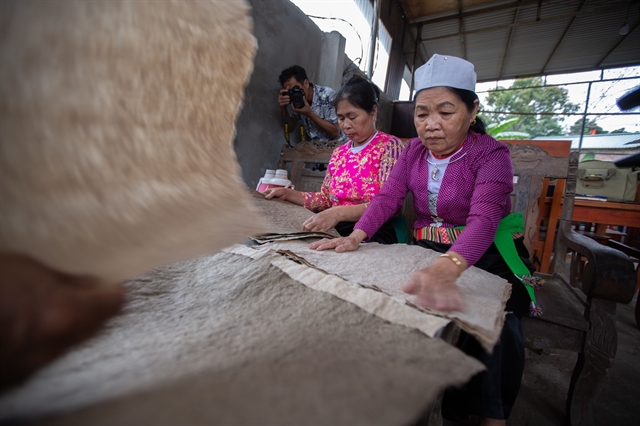 Sunday/Weekend
Sunday/Weekend

The craft of making poonah paper of the Mường people in Suối Cỏ Hamlet in Cao Sơn Commune, Lương Sơn District in Hòa Bình Province, has been passed down for many generations among the ethnic minority group for centuries.
In the old days, poonah paper (locally called dó) was made mainly for royal documents, altar paintings and prayer books. Nowadays, this kind of paper is a special material for artists in painting and interior decor.
.jpg) |
| The poonah paper-making process is laborious with over 30 working stages. The poonah tree bark will be soaked in water for two to three days to soften before it is boiled for 10 hours. — VNA/VNS Photo Trọng Đạt |
As making dó paper requires artisanal skills, there are only a few families in Suối Cỏ continuing the craft.
The process of making the paper is complicated, with roughly more than 30 stages, taking at least half a month.
Poonah paper is mainly made from the bark of dó trees. The bark will be soaked in water in a vat for two to three days to soften before being boiled for 10 hours.
The bark will once again be soaked in water for 7-10 days to release all the resin. The bark will then be ground into a mixture of wood pulp.
To form sheet the pulp mixture is poured into a mould. After the water has run off the mould the artisan flipped the newly formed sheet upside down and press it onto a couching screen. The thinness and smoothness of the paper depend on the ingenuity of the artisans during the paper couching process.
.jpg) |
| The thinness and smoothness of the paper depend on the ingenuity of the artisans during the paper couching process, which is often performed by women. — VNA/VNS Photo Trọng Đạt |
The wet paper sheets will be dried on a wooden screen, under the sun, for weeks to get the actual paper.
The final result is rustic yet the paper of beautiful texture on which ink does not run or smudge. Poonah paper is also highly resistant to humidity and is acid-free.
Alongside the main market in the North, for the Lunar New Year, souvenirs made from poonah paper by the Mường people in Suối Cỏ Hamlet can be popular items for tourists from other regions in the country and from abroad.
.jpg) |
| To form a sheet of paper the pulp mixture is poured into a mould. — VNA/VNS Photo Trọng Đạt |
According to Hoàng Văn Độ, chief of Suối Cỏ Hamlet, in recent years, the craft of making dó paper has become more widely known as several groups of Vietnamese and foreign tourists have visited the hamlet to learn about the traditional craft.
Aiming to preserve the cultural identity of local Mường ethnics, Lương Sơn District authorities have carried out policies to support household businesses in Suối Cỏ to nurture their craft, contributing to the development of a community tourism spot, and increasing income for local people. — VNS
.jpg) |
| The wet paper sheets will be dried on a wooden-framed screen, under the sun to get the actual paper. — VNA/VNS Photo Trọng Đạt |
 |
| The final result is rustic yet beautiful paper on which ink does not run or smudge. — VNA/VNS Photo Trọng Đạt |




